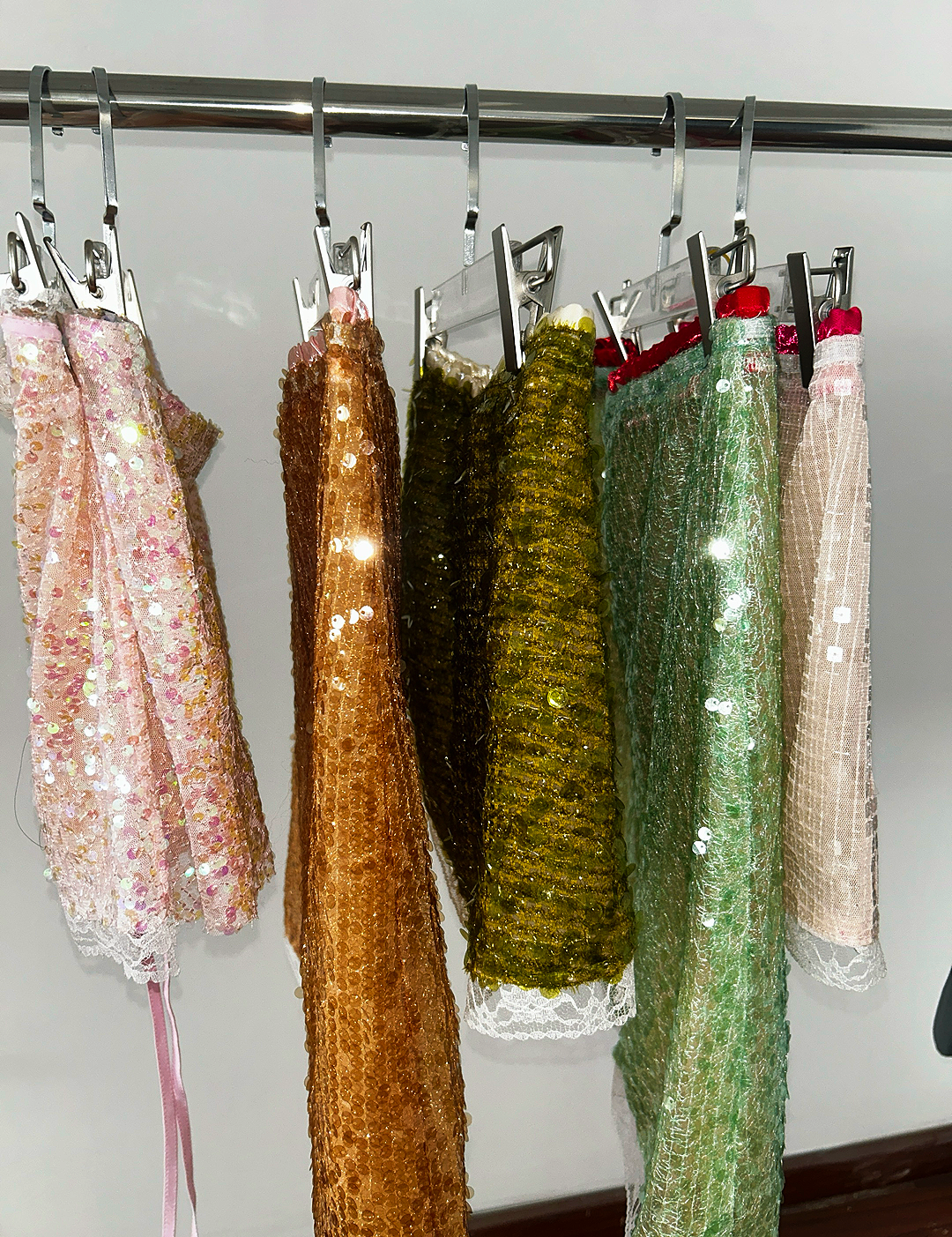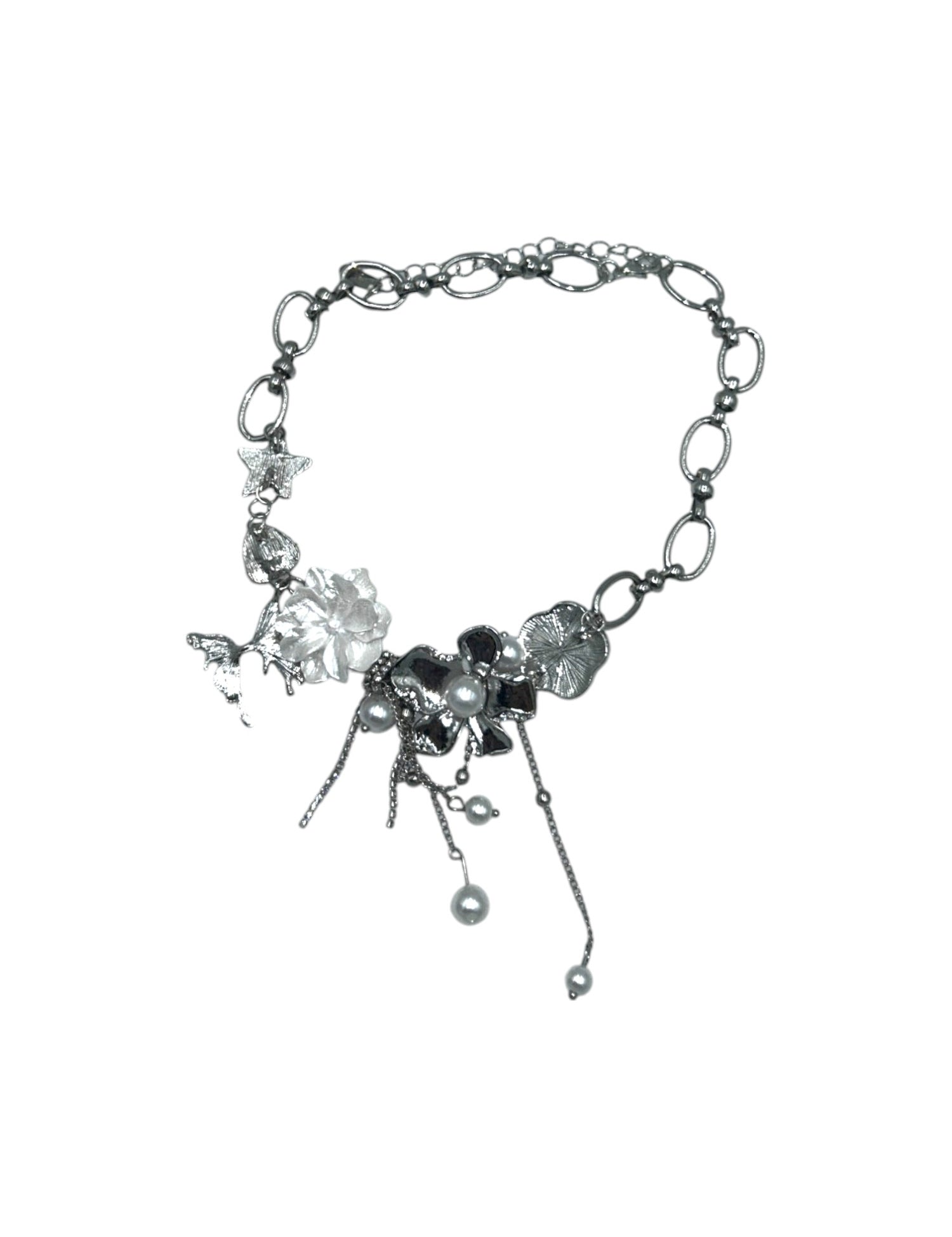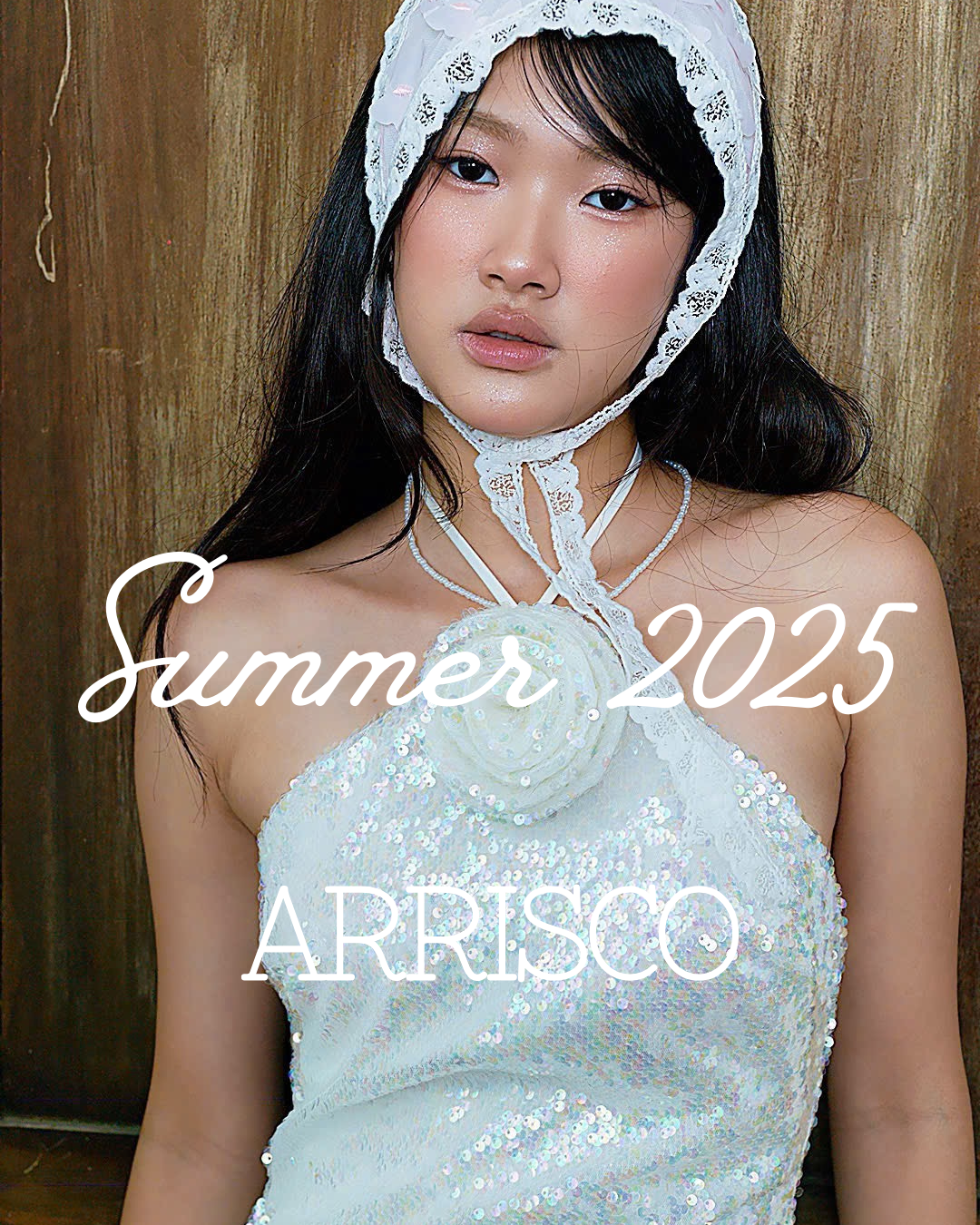Shopping for clothes online should be an absolute joy, not a roll of the dice. The secret? It's all about mastering your measurements and learning to decode size charts before you even think about clicking "add to cart." A little prep work here transforms confusing sizing into a clear-cut path to your perfect fit.
Find Your Perfect Fit Before You Click Buy
Let's get real for a second. The biggest headache with online fashion is that nagging sizing question: "Will it actually fit?" Is their "Medium" anything like my "Medium"? This one little uncertainty is a massive source of frustration.
It's a huge deal. While nearly half of all fashion retail sales are projected to happen online by 2025, a jaw-dropping 77.5% of e-commerce apparel carts are abandoned. A huge chunk of that hesitation boils down to the fear of getting the wrong size. You can dive deeper into these trends with this fantastic Capital One Shopping research on online clothing statistics.
But what if you could sidestep that guesswork entirely? The solution is way simpler than you'd think, and it all starts with a tool you probably have tucked away in a drawer: a flexible tape measure.
Start With Your True Measurements
Your first move toward online shopping glory is to create your own personal size profile. Seriously, forget the letter or number you typically grab off the rack in a store. From now on, your measurements in inches or centimeters are your new best friend. They give you a rock-solid baseline that cuts right through the chaos of inconsistent brand sizing.
Here are the essential numbers you need to know:
- Bust: Measure around the fullest part of your chest. Make sure the tape is level and not too tight.
- Waist: Find your natural waistline—it's usually the narrowest part of your torso, right above your belly button—and measure around it.
- Hips: Wrap the tape around the fullest part of your hips and butt. Again, keep it level all the way around.
- Inseam: This one can be tricky on yourself. The easiest way is to grab a pair of pants that fit you perfectly and measure from the crotch seam down to the hem.
This infographic is a great visual guide for getting it right.
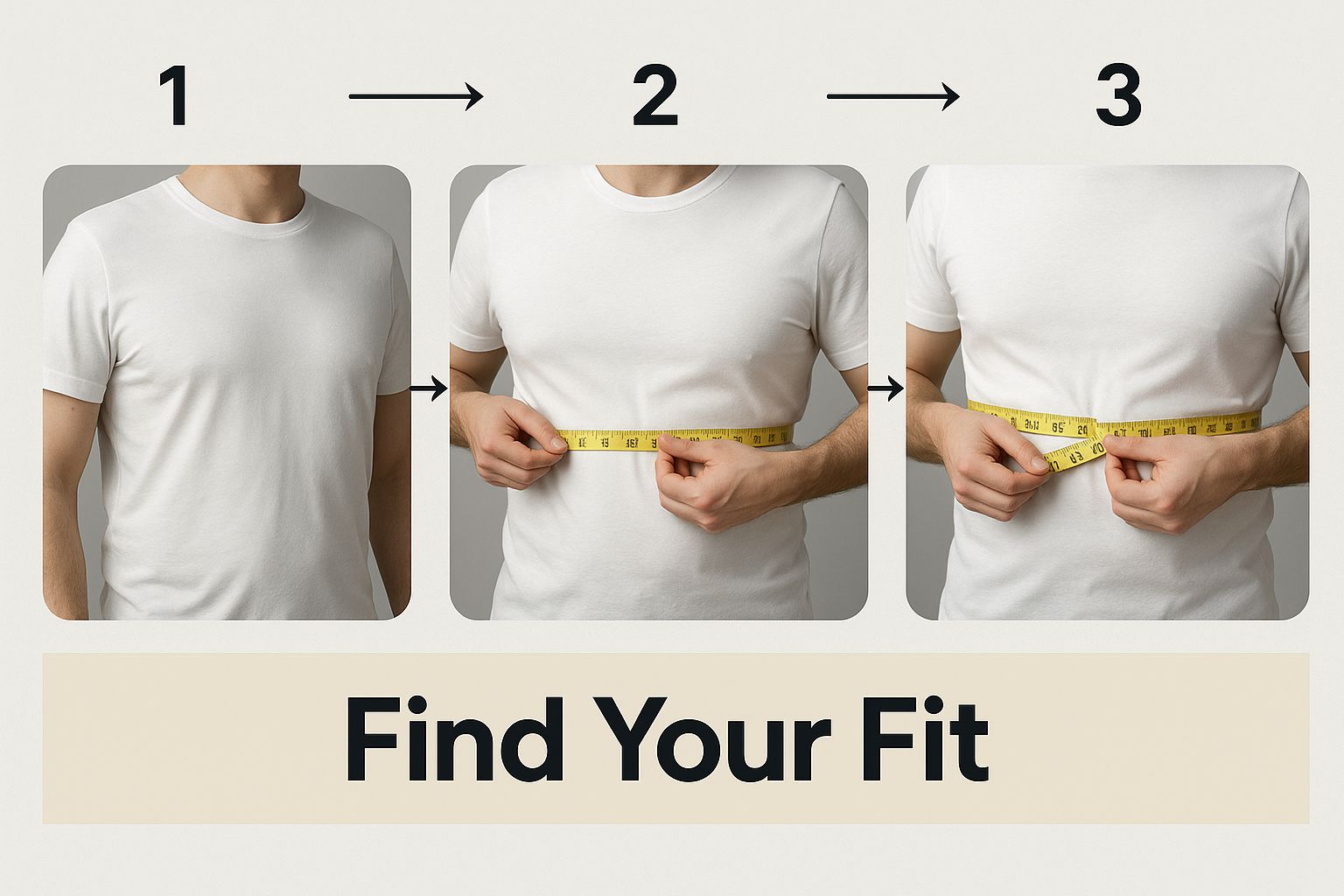
Knowing exactly where to place the tape measure makes all the difference in getting numbers you can truly rely on.
Your Personal Measurement Cheat Sheet
Keep this quick reference guide handy when checking size charts. Taking accurate body measurements is the single best way to improve your online shopping success.
| Measurement | Where to Measure | Pro Tip |
|---|---|---|
| Bust | Around the fullest part of your chest, keeping the tape parallel to the floor. | Wear a non-padded bra for the most accurate measurement. |
| Waist | Around the narrowest part of your torso, usually just above the belly button. | Don't suck in! Relax and measure at your natural waistline. |
| Hips | Around the fullest part of your hips and butt, keeping the tape level. | Stand with your feet together to get the widest point. |
| Inseam | From the inner upper thigh (crotch) down to the bottom of your ankle. | It’s easiest to measure a pair of well-fitting pants flat on the floor. |
Once you have these numbers written down, you're armed and ready to tackle any size chart the internet throws at you!
Decode the Brand's Size Chart
With your measurements in hand, your next step is to head straight to the retailer's size chart, which you can almost always find on the product page. And please, don't assume anything! A size 8 in one brand can easily be a 10 in another. This is where having your own measurements is a total game-changer.
If there's one habit to adopt, it's this: Ignore the size label (S, M, L) at first and focus only on matching your measurements to the chart. This single shift in approach will dramatically cut down on returns and that dreaded buyer's remorse.
Find yourself between two sizes? Look for clues in the product description. Phrases like "slim fit," "oversized," or "relaxed cut" will tell you which way to lean.
And when you're shopping from international brands, things can get even more confusing. A detailed international size chart conversion guide is your best friend here. It helps you accurately translate between US, UK, and European sizes, so you always know you're picking the right equivalent, no matter where your new favorite piece is coming from.
Become a Digital Fabric Detective
You've got your measurements down, which is awesome. But what about the feel of the clothes? Since you can't reach through the screen (yet!), learning to read the language of fabric is your next shopping superpower. Think of the product description as your personal treasure map—it tells you how a garment will drape, stretch, and actually live with you in the real world.
Every fabric has its own personality. Cotton is that reliable, down-to-earth friend—sturdy, breathable, and always there for you. Rayon, on the other hand, is the smooth, drapey artist in the group, giving you that gorgeous, fluid fall. Getting this distinction is everything.
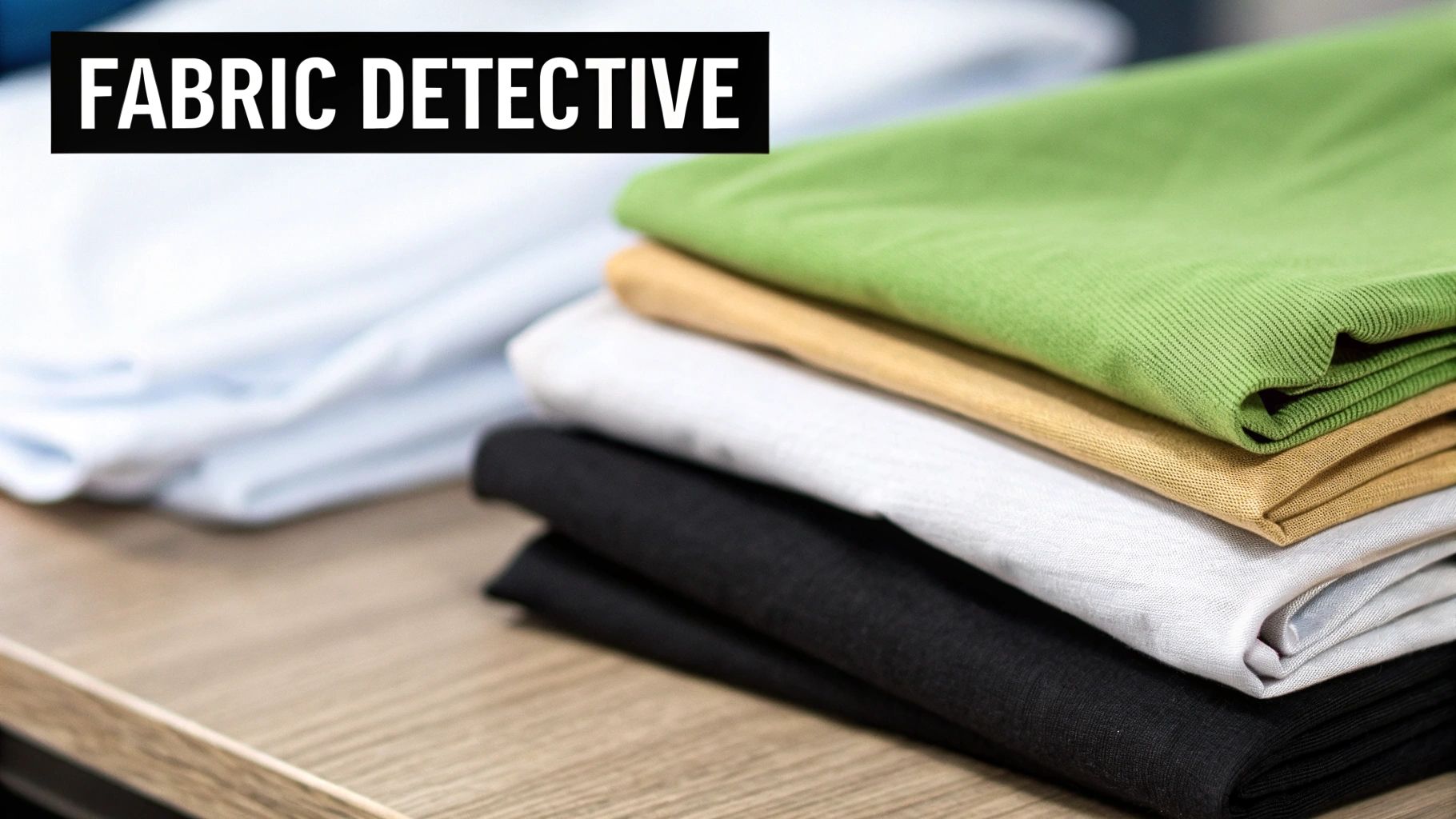
Understanding these little details helps you predict not just comfort, but the entire vibe of an outfit. It's the difference between a crisp poplin shirt that holds its shape and a silky viscose blouse that moves when you do.
Read Between the Weaves
Let’s get into the nitty-gritty. When you see a blend of materials, it’s not just a random list; it's a recipe for a specific experience. A pair of jeans made from 98% cotton and 2% elastane? That’s your classic, structured denim but with that crucial hint of forgiving stretch that makes all-day wear a total dream.
On the flip side, a dress that's 100% linen is your golden ticket to a breezy, lightweight feel, absolutely perfect for a hot day. Of course, you also know to expect its signature effortless wrinkles—but hey, that’s part of its charm!
The real secret to becoming a fabric pro is all in the percentages. That tiny bit of spandex, elastane, or lycra can completely transform how a piece fits and feels, often making it infinitely more comfortable and wearable.
This knowledge is pure power. It lets you visualize the final product before it even lands on your doorstep. A polyester-spandex blend basically screams "smooth and stretchy," making it a no-brainer for activewear or anything body-hugging. A wool-cashmere mix? It just whispers "soft, warm, and luxurious," perfect for that cozy sweater you'll live in all winter. If you want to go even deeper, this guide to unraveling the secrets of fashion fabrics is a game-changer.
Use Your Eyes to "Touch" the Fabric
High-resolution photos are your new best friends. Seriously. Don't just glance at the model—use that zoom feature like you're inspecting a diamond. This is where you can spot the all-important clues about quality.
Get up close and personal and look for these details:
- The Weave: Can you see a tight, consistent weave on those trousers? That suggests they're built to last. Is the knit on that sweater chunky and defined, or is it loose and airy? That tells you everything about its weight and warmth.
- The Sheen: Does the fabric have a subtle, healthy glow like silk or satin? Or is it flat and matte like a comfortable jersey knit? The way light hits the surface gives you major hints about the texture.
- The Texture: Zoom way in on materials like corduroy, tweed, or lace. Good-quality images will let you see the depth of the texture, helping you imagine exactly how it would feel against your skin.
When you combine what you know about fabric types with a sharp visual inspection, you can start to confidently predict an item's real-life feel and quality—all without ever leaving your couch.
Use Shopping Tech to Your Advantage
Okay, let's talk about the fun stuff! Beyond static size charts and fabric descriptions, the best online stores are rolling out some seriously cool tech to help you shop. Think of it less like a digital catalog and more like having a personal shopping assistant right on your screen. These tools are designed to take the guesswork out of the equation, making the whole experience feel like it’s built just for you.
For example, many brands I love are now using AI-powered size recommenders. These clever tools don't just look at a chart; they analyze your past purchases (and even what you've returned) and compare your data with thousands of other shoppers. The result? A surprisingly accurate size suggestion that gives you that extra boost of confidence before you click "buy."
See It Before You Buy It
One of the most exciting tools popping up everywhere is virtual try-on. I mean, how many times have you wondered how a dress will really drape or if a certain neckline will actually flatter you? This is where that guesswork ends. This tech lets you see the garment on a model that matches your body type or, in some cases, even lets you upload your own photo for a preview.
It completely flips the script from hoping an item looks good to knowing it will. It’s becoming more and more common, so keep an eye out for it!
When you use these digital tools, you’re doing more than just buying clothes—you’re crafting a smarter, more personalized shopping journey. The goal is fewer returns and more of that "I found the perfect thing!" feeling.
If you’re curious about the magic behind it all, this is a great breakdown of how virtual try-on technology works and how it creates such realistic previews.
The Future of Personalized Fit
And it doesn’t stop there! Some of the most forward-thinking brands are using 3D body scanning right from your smartphone camera. You literally take a quick scan, and it creates a super-precise digital model of you, leading to hyper-personalized fit and style recommendations. It’s wild, and it works!
Here’s a quick look at the kind of tech to watch for:
- AI Recommenders: Systems that learn your unique style and fit preferences over time.
- 3D Body Scans: Apps that use your phone’s camera to capture your exact measurements.
- Augmented Reality (AR) Try-Ons: Tools that overlay clothes onto your live image through your camera for a real-time feel of the fit and style.
These features are popping up more and more, making it so much easier to find pieces you'll absolutely love. To see what's possible, you can dive deeper into how virtual try-on technology is transforming retail and get ready for your next shopping trip.
Read Customer Reviews Like a Pro
Okay, you’ve found the one. The fabric sounds dreamy, the size chart makes sense, and you’re already picturing it in your closet. Hold on! Before you hit "buy now," it's time to tap into your most powerful tool for shopping success: customer reviews. This is where you get the real, unfiltered tea from people who have already bought the item.
Think of the review section as your personal team of scouts. It’s absolutely packed with priceless intel, but you have to know how to sift through the noise to find the gold. Don't just glance at the star rating; the real magic is in the details.
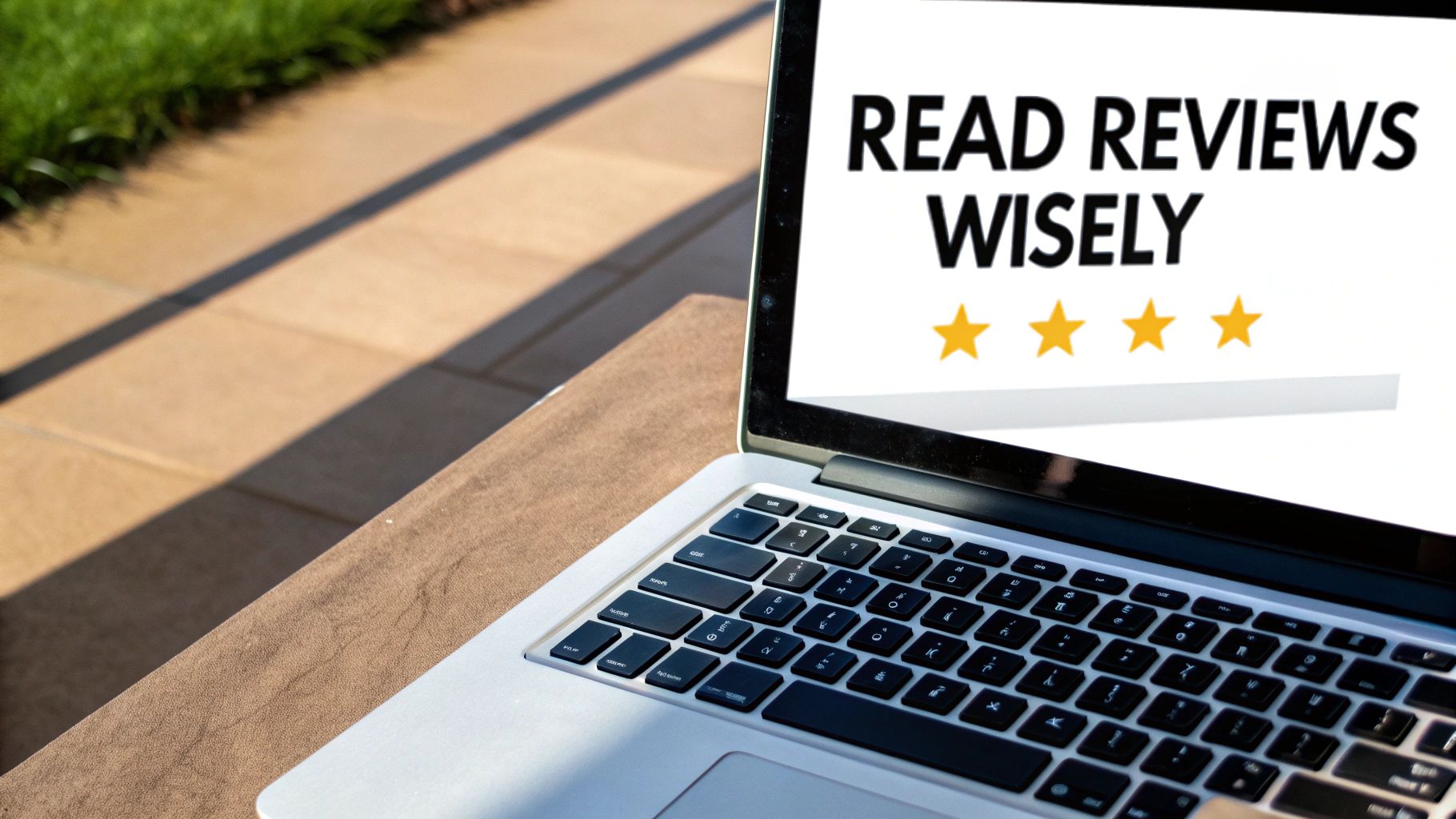
Your first move? Completely ignore the super-vague comments like "Loved it!" or "Hated it." They tell you nothing. You're on the hunt for the juicy, descriptive reviews that paint a clear picture.
Find Your Fashion Twin
This is the fun part. Your mission is to find reviews from someone who sounds just like you. So many sites now let you filter reviews by the shopper’s height, weight, and the size they bought. This feature is an absolute game-changer! A single review from someone with your exact height and build is 100 times more valuable than a dozen random ones.
Keep an eye out for reviewers who describe their body type, like "perfect for my pear shape" or "a little tight across my broad shoulders." This is the specific, actionable feedback that lets you truly visualize how that dress or pair of jeans will fit your body, not just the model's.
The best reviews are the ones that connect the dots. When someone says, "I'm always a size 10, and the Large fit me perfectly," you can bank on that. It's so much more helpful than a generic comment.
When you do this, you’re not just reading reviews anymore—you’re getting a personalized fit consultation.
Decode the Real Story
Next, you need to learn how to separate a real problem with the product from a one-off complaint that has nothing to do with the garment itself.
- A Real Product Flaw (Red Flag): Are multiple people saying the "fabric started pilling after one wash"? Or that the "color is way brighter in person"? That’s a pattern, and it points to a genuine quality or representation issue.
- A One-Off Issue (Safe to Ignore): A single complaint about "slow shipping" or a "damaged box"? While annoying for that person, it tells you zip about the sweater you’re about to buy.
Having a critical eye helps you focus on what actually matters—the quality and fit of the clothing. It's also smart to see how a brand responds to feedback. Our deep dive into Arrisco's customer care reviews, for instance, shows how great service can build trust and offer even more insight.
The world of online fashion is always moving, with Asia leading the pack in new shopping tech. The region is on track to generate an incredible $520.93 billion in e-commerce fashion revenue in 2025, and it’s where many of the features we love today got their start. You can learn more about these massive e-commerce fashion trends and how they’re changing how we shop. By mastering the art of reading reviews, you're using one of the most effective tools out there to shop smarter, not harder.
Think of the Return Policy as Your Secret Weapon
Let’s be real: a good return policy is the ultimate safety net for online clothes shopping. It’s what transforms a risky click into a confident purchase. Before I even think about adding something to my cart, I make a beeline for the store’s return policy. This isn't just a box to check; it’s my secret weapon.
Honestly, a brand’s return policy tells you everything you need to know about them. A flexible, generous policy screams confidence. It tells me they stand behind their clothes and truly care about my experience. A complicated, restrictive one? That's a huge red flag.
What Makes a Return Policy Great?
So, what separates a good policy from a great one? It’s all in the details—the little things that make your life easier if something doesn't work out.
Here’s exactly what I look for:
- The Return Window: How much time do I actually have? A generous 30, 60, or even 90 days is fantastic. It gives you room to breathe. A short 14-day window means you have to make a decision, fast.
- Return Shipping Costs: Who pays? Free return shipping is the absolute gold standard. Having to shell out cash to send something back just adds insult to injury.
- The Refund Method: Are you getting your money back on your credit card, or are you stuck with store credit? This is a huge one. I always want to know if I'm getting cash back or being locked into shopping there again.
A truly amazing return policy is simple, clear, and puts you first. If you have to read a page of legal jargon to understand it, that's a red flag. The best brands make returns effortless because they want you to shop with absolute confidence.
Not All Policies Are Created Equal
I've seen it all—from brands that bend over backwards to make returns a breeze to others that seem designed to make you give up. For example, understanding product return policies is a crucial skill, and seeing how a straightforward policy is laid out can show you what to look for.
A dream policy offers a full cash refund and a pre-paid shipping label. The whole process is seamless. On the flip side, a nightmare policy might be "exchange only" or sneak in a "restocking fee." That friction is a dealbreaker for me. And when you do run into issues, knowing how to contact customer service quickly can save you a massive headache.
In an industry as massive as the global apparel market—projected to hit $1.84 trillion in 2025—customer-friendly policies are how the best brands stand out. They know that earning your trust is everything. So, learn to read these policies like a pro. You're not just protecting your wallet; you're choosing to shop with brands that actually deserve your business.
Your Burning Online Shopping Questions, Answered
Alright, let's get into the nitty-gritty. Even with the best game plan, a few nagging questions can pop up right as you're about to click "buy." Think of this as your personal FAQ for those last-minute moments of doubt.
You’ve done your homework—you’ve measured, you’ve decoded the fabrics, you’ve sifted through reviews. Now, let’s tackle the common curveballs that can still throw you off your game. We'll make sure nothing stands between you and that perfect find.
What Should I Do If I Am Between Sizes on a Chart?
This is the classic online shopping conundrum, isn't it? That frustrating moment when your measurements land perfectly between a Medium and a Large. It can feel like a total dead end, but don't throw in the towel just yet. You've got a few savvy moves.
First, go straight back to the customer reviews. This is your secret weapon. Search for phrases like "runs large," "snug fit," or "true to size." Real-world feedback from people who've already tried it on is worth its weight in gold. If the reviews are all over the place, your next clue lies in the fabric.
- Forgiving Fabrics: Anything with a little stretch—like blends with spandex or elastane—gives you some wiggle room. If you prefer a more tailored, body-hugging look, you can often get away with sizing down in these materials.
- Rigid Fabrics: Now, for fabrics with zero give—think 100% cotton denim, linen, or organza—sizing up is almost always the smarter call. Trust me, it's a whole lot easier to have a tailor take something in than it is to try and magically create more fabric.
And finally, read the product description like a detective. Does it mention a "relaxed fit" or an "oversized cut"? You can probably opt for the smaller size. But if it says "slim fit" or "bodycon," that's your cue to size up for a more comfortable fit.
How Can I Tell the True Color of an Item Online?
Oh, we've all been there. You excitedly order what you think is a gorgeous "sage green" dress, only to open the box and find something closer to a shocking neon lime. Between professional studio lighting and varying screen calibrations, colors can get seriously twisted online. But you can learn to spot the truth.
Start by looking beyond the basics. A creative color name like "terracotta" or "dusty rose" gives you way more information than a simple "red" or "pink." Next, become a treasure hunter in the review section and look for customer-submitted photos. These unfiltered, real-world pictures are often the most accurate glimpse you'll get of the item's true shade.
Here's a pro tip I swear by: always watch the product video if there is one. Seeing how the light hits the fabric as the model moves reveals its undertones and depth in a way a static photo just can't match.
And be a little skeptical of those super-stylized photos with dramatic, colorful backgrounds. Images shot against a clean white or simple gray backdrop are usually your most reliable bet for color accuracy.
Are Final Sale Items Ever Worth the Risk?
Ah, the siren song of the final sale section! The deals are so tempting, but the "no returns" policy is terrifying. These items can be incredible scores, but they can just as easily become permanent (and unworn) residents of your closet. The trick is to be incredibly strategic.
I only ever pull the trigger on a "final sale" item under a few very specific conditions:
- You're a Brand Loyalist. You've bought from this brand before, you know their cuts, and you are 100% confident in how their sizing works for your body.
- The Fit is Forgiving. It's an item where a perfect fit isn't the be-all and end-all. Think flowy scarves, oversized tote bags, or a cozy, loose-knit sweater.
- The Price is a Steal. The discount is so deep that you're okay with the gamble. If it doesn't work out, the financial hit won't sting too much.
And one non-negotiable rule: never, ever buy a final sale piece for a major event. A wedding, a big presentation, a job interview—the risk of a bad fit with zero recourse is just too high when the stakes matter.
What Is the Best Way to Track Sales and Favorite Items?
There's nothing more frustrating than seeing an item you've been eyeing sell out or realizing you just missed a huge sale. The good news? You can easily keep tabs on price drops without refreshing the page every five minutes. The "wishlist" or "favorites" feature on most shopping sites is about to become your best friend.
By saving items to your list, you're essentially creating a personal shopping command center. Many retailers will then automatically shoot you an email the second one of your saved items goes on sale. It's simple, it's brilliant, and it lets the deals come to you.
Want to take it a step further? Browser extensions are fantastic for this. Services like Honey or Capital One Shopping can track prices for you across the web and even automatically search for coupon codes at checkout. It’s like having a personal deal-hunting assistant.
At Arrisco, we truly believe that shopping for clothes online should feel empowering and fun, not stressful. By blending timeless style with smart technology like our virtual fit tools, we're here to make your experience confident and joyful.
Explore our latest collections and find pieces you'll love, completely risk-free.

